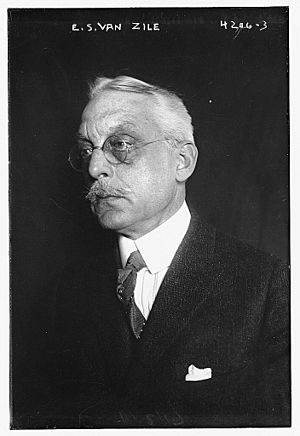Edward Sims Van Zile facts for kids
Quick facts for kids
Edward Sims Van Zile
|
|
|---|---|

Van Zile circa 1917
|
|
| Born | May 2, 1863 |
| Died | May 29, 1931 (aged 68) |
| Cause of death | stroke |
| Education | Trinity College, Hartford, Connecticut |
| Title | Doctor of Letters (honorary) |
| Parent(s) | Oscar Edward Van Zile Sarah Melinda Perry |
Edward Sims Van Zile (May 2, 1863 - May 29, 1931) was an American writer. He wrote many different kinds of books. These included stories, true-life accounts, and even books about war and the early days of movies. He was known for his short stories and novels.
About Edward Sims Van Zile
Edward Sims Van Zile was born on May 2, 1863. His hometown was Troy, New York. His parents were Oscar Edward Van Zile and Sarah Melinda Perry. His family came from the Netherlands (Holland) a long time ago.
As a boy, Edward loved to read. He read about all sorts of topics. He went to Trinity College in Hartford, Connecticut. He finished college in 1884. Later, in 1904, the college gave him a special award. It was an honorary degree called Doctor of Letters. Besides books and articles, he also wrote the words for a musical comedy.
In 1887, he married Mary Bulkeley. They had a daughter named Winifred. Sadly, Winifred passed away in 1902. Edward Van Zile died on May 29, 1931. He was 68 years old. He passed away from a stroke at his home in New York City. He was buried in Cedar Hill Cemetery in Hartford, Connecticut.
How Edward Van Zile Changed Baseball
Before Edward Van Zile, watching baseball games was different. By 1876, baseball scores were sent by telegraph. This happened after each inning. Fans who wanted to know the scores right away would wait at newspaper offices. Some newspapers even used blackboards. They tried to show how the game was going.
In 1888, Van Zile worked for the New York World newspaper. He was an editorial writer. One day, he was drawing on a notepad. He was sketching a baseball diamond. He later said he was thinking about it without even trying. He drew pegs on the diamond. These pegs showed where the players were. They also showed other game information.
A man named Edwin Grozier saw Van Zile's drawing. He told Van Zile, "You should get that idea patented!" He even offered Van Zile money for his idea. Van Zile called his invention a "Bulletin Board and Base Ball Indicator." He applied for a patent in 1888. He received the patent in 1889.
This invention was a huge step forward! It made it much easier to follow baseball games. The World newspaper put a giant version of it outside their office. This was for the baseball championship series that year. It was a massive success! Crowds of up to 6,000 people gathered. They watched to get a play-by-play view of the games.

